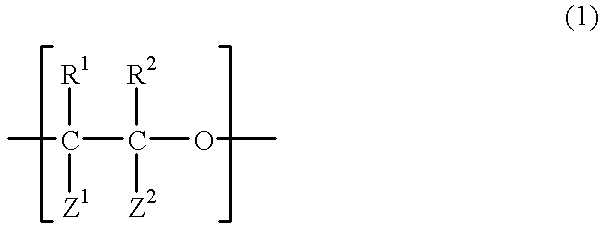Anti-shrinkage agent for hydraulic material
a technology of anti-shrinkage agent and hydraulic material, which is applied in the direction etc., can solve the problems of reducing the strength and durability of hydraulic materials, lowering the strength and durability of hydraulic materials, and reducing the strength and durability of civil engineering and architectural structures, so as to reduce the water content of hydraulic materials and improve the effect of mechanical properties
- Summary
- Abstract
- Description
- Claims
- Application Information
AI Technical Summary
Benefits of technology
Problems solved by technology
Method used
Image
Examples
production example 1
[0159] A glass reactor equipped with a thermometer, a stirrer, a nitrogen inlet tube and a reflux condenser was charged with 120.0 parts of Softanol 30 (trademark, product of Nippon Shokubai; C.sub.12-14 secondary alcohol-ethylene oxide (EO) (3 moles on average) adducts, molecular weight 332, molecular weight distribution (Mw / Mn)=1.36) and 15.5 parts of maleic acid, and the charge was heated to 125.+-.5.degree. C. in a nitrogen atmosphere for melting and mixing up. Then, while maintaining the temperature at 125.+-.5.degree. C., 14.5 parts of acrylic acid and 3.3 parts of tert-butylperoxy isopropyl carbonate (trademark Perbutyl I, product of Nippon Oil and Fat) were separately added dropwise continuously over 1 hour. Thereafter, stirring was continued at 125.+-.5.degree. C. for 1 hour, to give a graft polymer (graft polymer 1).
[0160] The graft polymer 1 had a weight average molecular weight (Mw) of 11,700 and a molecular weight distribution (Mw / Mn) of 16.8. The graft polymer 1 also h...
production example 2
[0163] A stainless steel pressure reactor equipped with a thermometer, a stirrer, a nitrogen inlet tube and a pressure gage was charged with 601.0 parts of isopropyl alcohol (product of Wako Pure Chemical Industries; moisture content 0.04%) and 0.4 part of sodium hydroxide. The pressure reactor inside was purged with nitrogen with stirring, and the pressure reactor inside was heated to 100.+-.5.degree. C. Then, 1,321.5 parts of ethylene oxide was introduced into the reactor at a temperature of 100 to 140.degree. C. and a safety pressure of 2.0.times.10.sup.-1 to 7.8.times.10.sup.-1 MPa. After maturation, the volatile matter was removed to give an intermediate (intermediate a), namely an isopropyl alcohol-ethylene oxide adduct.
[0164] The molecular weight of intermediate a was determined based on its hydroxyl value and found to be 245.8. Thus, the average number of moles of ethylene oxide added to isopropyl alcohol was calculated at 4.2.
[0165] Then, a stainless steel pressure reactor ...
production example 3
[0170] A commercial shrinkage reducing agent, Tetraguard AS21 (trademark, product of Taiheiyo Cement) comprising lower alcohol-derived alkylene oxide adducts had a water content of 14.6% as measured by a moisture meter. Therefore, it was dehydrated under reduced pressure and warming using an evaporator (50.degree. C., not higher than 1.3.times.10.sup.-2 MPa) and further dehydrated thoroughly in a vacuum drier (50.degree. C., not higher than 6.7.times.10.sup.-3 MPa) to give dehydrated Tetragurad AS21 (moisture content 0.4%). The dehydrated Tetragurad AS21 thus obtained had a hydroxyl value of 181.7 mg / g. Based on this result, the average molecular weight of Tetragurad AS21 was calculated at 309. The molecular weight distribution (Mw / Mn) of Tetragurad AS21 was measured and found to be 1.13.
[0171] A glass reactor equipped with a thermometer, a stirrer, a nitrogen inlet tube and a reflux condenser was charged with 80.0 parts of the dehydrated Tetragurad AS21 (trademark, product of Taihe...
PUM
| Property | Measurement | Unit |
|---|---|---|
| molecular weight distribution | aaaaa | aaaaa |
| temperature | aaaaa | aaaaa |
| temperature | aaaaa | aaaaa |
Abstract
Description
Claims
Application Information
 Login to View More
Login to View More - R&D
- Intellectual Property
- Life Sciences
- Materials
- Tech Scout
- Unparalleled Data Quality
- Higher Quality Content
- 60% Fewer Hallucinations
Browse by: Latest US Patents, China's latest patents, Technical Efficacy Thesaurus, Application Domain, Technology Topic, Popular Technical Reports.
© 2025 PatSnap. All rights reserved.Legal|Privacy policy|Modern Slavery Act Transparency Statement|Sitemap|About US| Contact US: help@patsnap.com


